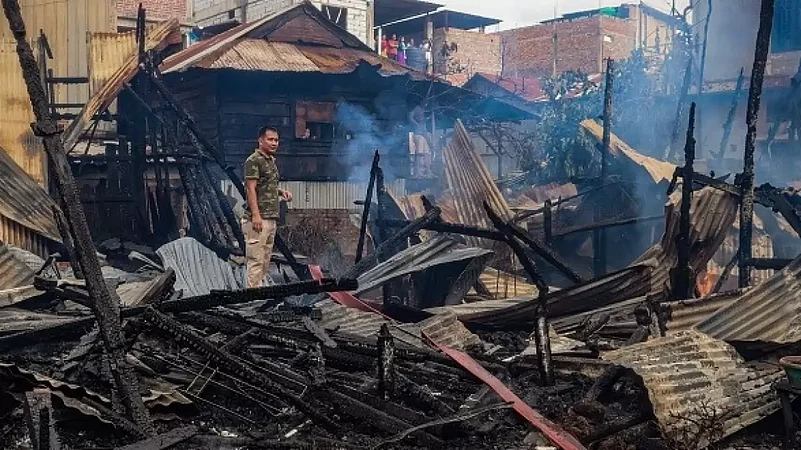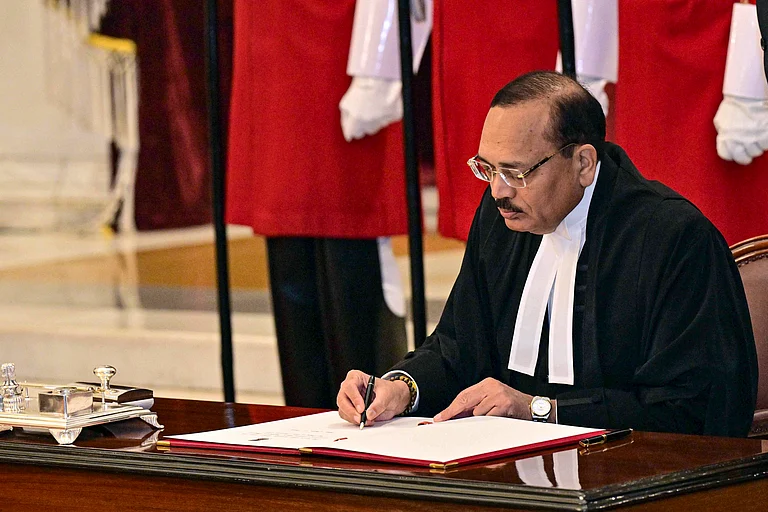In Manipur, a prolonged clash between two ethnic groups - Kukis and Meiteis - has led to widespread violence, death and displacement. Conservative estimates put the number of deaths at 80 while over 40,000 people have been displaced from their homes. In many cases, there are no homes led to return to. While all Kukis have been violently expelled from Imphal, no Meiteis can be seen in Churachandpur or other Kuki-dominated hill districts.
The lines of division have become sharper than ever with both communities expressing mistrust, anger and even hate against the other. It all started on May 3 when a tribal solidarity march organised by tribal civil society bodies in Churachandpur turned violent. The purported cause for the clashes appears to be the dominant and politically stronger Meitei community’s demand for ST status. The Meiteis, who form about 60 per cent of the population, can currently reside in just 10 per cent of the total land area in Manipur. The rest of Manipur - consisting of hill districts - belongs to the tribals, mainly Kukis and Nagas.
However, a closer analysis of the incidents that unfolded in Manipur reveals not just burgeoning ethnic tensions but deeper divides - between a valley and the hills, between shifting and settled agriculture, between state and non-state, between so-called ‘civilised’ and ‘anarchist’.
Agriculture and the Conflict of ‘State and Non-state’
In the Art of Not Being Governed — An Anarchist History Of Upland Southeast Asia, anthropologist James C Scott outlines how state formation in the valleys creates sections that are “non-state” that inhabit the hills. At the core of this distinction between state and non-state is “surplus”.
Imphal-based political analyst Pradip Phanjouban explains that surplus is the necessary first step of the process of state formation and intellectual/political/economic activity. Thus, communities practising shifting agriculture in hills and making frugal produce that lasts from season to season remained left out of the process, meaning they became “non-state”.
History shows various examples of how settled rulers, especially in indigenous societies, maintained peace with hill tribes. In Assam, for instance, the Ahom kings evolved the Post system wherein villages provided certain goods that the tribes needed to survive through lean seasons in exchange for peace. The logic was that in case of a raid, both parties suffered (the Ahoms would have raided back and done more damage). This helped maintain peace between the valley and the plains.
When the British came, they wanted to draw the lines between what is in the state realm and what is in the non-state realm by categorising who was more “civilised” and could easily be aligned with the British culture of governance and society. They also monetised the indigenous systems like the Posa by replacing the kind given to tribes with cash. This further established the divide between state and non-state as it forced tribal chiefs to come to face to face with bureaucracy and become part of the “civilised” channels of administration.
Today, the conflict between the Kukis and Meiteis in Manipur, Phandjouban feels, is largely a conflict between the “state” and “non-state”.
The Naga factor: a fight for resources
But why did it happen with the Kuki-Zomi and allied Chin tribes and not the Nagas? Here’s another question.
In history, there’s no denying that the Nagas and the Meiteis were here in Manipur from the beginning. If you look at historical records and older chronicles, Kukis were hardly mentioned. In fact, it was with the influx of the British that Kukis started settling in these regions. The British always had the idea of balancing one tribe against the other. So Kuki villages were allowed to be set up adjacent to Naga villages or Naga-dominated areas like Thangkhul. That’s how the hills became a mixed population area and despite inter-tribe rivalries, Kukis became an established part of the Manipuri population.
However, in recent years, Manipuri society has seen a revival of “Meiteism”: a concerted effort to revive Meitei identity, religion and culture (often aligned with Hinduism). The movement foremost establishes Meiteis as the original inhabitants of Manipur. Not just Meiteis, the Nagas to have added to the chorus.
The Nagas and Kukis have had their own history of bloody conflict, owing to their different and often conflicting patterns of agriculture and land ownership. Jhum cultivation which is the traditional Kuki way of agriculture did not allow for the proliferation of large, self-sustainable villages, meaning Kukis often formed small villages dispersed across an area that kept moving to newer pastures. Additionally, according to land ownership systems among Kukis, only the chief’s elder son could inherit the chiefship of a village. The other sons often ventured out to set up their own villages. This expansionist attitude has often put them at odds with the Nagas. Such a flare-up was seen in 2020, days ahead of the nationwide coronavirus lockdown, when the Nagas and Kukis feuded with each other in the Thangkhul area where a Kuki village, Chassad, was allegedly burnt by Nagas.
The accusations prompted a response from Nagaland’s NSCN-IM led by Ishak Muivah which in a statement declared that Nagas and Meiteis are the only indigenous communities of Manipur since time immemorial and that the Kukis came to settle in Manipur recently, and in waves, as a way of the British to “buffer” Naga militancy.
Nagas, nevertheless, have maintained neutrality this time as they claim to be more focused on the status of the ongoing peace talks of NSCN-IM with the Centre. “For the Nagas, there is only one demand, that of the Final Solution in Nagaland. Peace talks are at present going on between the NSCN-IM and the Indian government. Naga people are waiting for that solution. At the moment, that’s all that Naga people want,” states Ashang Kasar.
Ostracisation, Othering And the Kuki Identity
In the wake of violence, Kuki MLAs and civil society groups in Manipur have demanded the establishment of separate administration for the hill districts of Manipur. While the Nagas have also opposed the demand for ST status by the Meiteis, they remain neutral on the matter of separate administration.
“When Kukis had initially started the demand for separation, they had not included the Nagas. But this time, they have been wiser and have included us in the demand. They are demanding separation under the umbrella of tribals. But Nagas have to wait and watch how the situation unfolds with Centre,” Kasar states.
Apart from tribal ethnic dynamics, scholars note yet another - and one of the most important factors - that led to the current conflict - the role of the state and the rising “Meitei nationalism” in Manipur.
For years, the Meitei-dominated governments of the Manipur have remained alienated spaces for Kukis who find themselves labelled as “outsiders”, “illegal immigrants” and “poppy cultivators”. With the coming of Biren Singh as Chief Minister, these narratives seem to have got a further fillip.
Biren Singh has been known for his “anti-Kuki” rhetoric from his early days in Congress and many, especially the Kukis, accuse him of peddling fake narratives against the community. “He uses words like a foreigner, illegal immigrant, and makes threats to the community,” states L Haokip.
Several Kuki MLAs including ones working in BJP have renounced Singh’s approach to Kukis. Paolienlal Haokip, BJP MLA for Saikot in the Churachandpur district of Manipur, has called Singh an “anti-Kuki” man who is “prejudiced”, the Wire has reported. Many Meiteis like Pradip Phanjouban believe that the CM’s attitude of “othering” of the Kukis added to the community’s anger and alienation. “The ongoing narratives would have made the Kukis very sensitive, pushed against the wall. And when you are pushed against the wall, you respond with more force. That may perhaps answer the question - why did the Kukis react like that and not the Nagas,” Phanjouban adds.
Thangminglen Kipgen, Vice President of Kuki Inn Kangpokpi and spokesperson for Kuki Innpi Manipur, the apex body for Kukis in the state, states that this process of hatred against and othering of the Kukis had been going on for the past two-three years through the support and ignorance of a certain community who villainised another community. Others from Kuki Innpi like Dr L Haokip who works for the Congress state that newly formed Meitei groups like Arambai Tenggol and Meitei Lipul have been carrying out divisive campaigns by travelling door-to-door in Meitei and Gorkha-dominated areas in the hills where they have been trying to work up the Meiteis and Gorkhas against the Kukis.
A recent eviction drive by the state government to clear reserved forest lands under FRA has also led to the displacement of Kuki villages without any rehabilitation. “Instead, they have tagged us as illegal immigrants and poppy cultivators,” Haokip states.
Many like Haokip and Kipgen among others in the Kuki community feel that separate administration can be the only solution. “The Kukis have now seen the opportunity for pushing for separation. However, it needs to be done in a systematic and constitutional manner, not through force or anarchy” Ashang Kasar states. With Amit Shah personally assuring Biren Singh that Manipuri's integrity will not be harmed, many in Manipur remain wary of future developments and potential violence.
In light of the historical dynamics between the hill and valley communities, the demand for separate administration by Kukis could also perhaps be seen as the community’s first step toward state formation - an attempt to shift from a “non-state” entity to a “state” entity.
But will the dominant Meiteis allow it? And how would such a development impact international geopolitics in the highly sensitive region that borders Myanmar and is close to China?


























